Have you thought about using trees in container gardens – or perhaps, shrubs? Maybe not, but container gardening can be more than just urns
of flowering annuals or hanging baskets.
Larger plants can . . .
- Give your garden area form or structure
- Provide a background for your flowering plants
- Offer another opportunity to grow edibles with fruit varieties
- Add a sense of permanence to your garden area
- Be enjoyed year’round
- Provide privacy
- Act as a landscaping device
Types

Planting trees in container gardens is just like planting anything else except your plant and your container are larger.
The
best trees for containers are small and slow growing with
compact root systems. Don’t choose varieities that drop lots of seeds, leaves or messy fruits during the growing season. They will keep your patio, deck or balcony a mess.
Look for
trees that have something to offer all year – blooms in spring, colorful fall foliage or berries. Choose a
variety that is suited to your climate and the growing conditions in your garden areas.
Like other plants, different varieties of trees can tolerate shade, wind, pollution or salt spray trees better than others. Some of the best container-friendly trees aren’t hardy enough to to
remain outdoors year round excdpt in mild climates. If you live in an area with cold winters, you will need to move container trees to protected areas.
Lots of varieties work in planters,
but dwarf varieties and those with slow growth are the easiest. Conifers –
especially evergreens – require less food and nutrients than trees with broad leaves. They also adapt better to the restricted root area of containers.
Pines and junipers grow well in dry soil which is common with container gardens. Bamboo trees (to the left) grow quickly in containers and make great privacy screens.
Add a topical flair to your outdoor areas with palm trees. Check out smaller palm varieties that work great in containers.
Know your climate zone. The roots of trees in container gardens are more exposed to temperature swings than those planted in the ground. Many experts advise that you plant varieties that will live in one zone colder or warmer than your own.
You can also move containers to a protected area during the winter if you want to plant types that won’t do well in extreme cold or heat – just make sure you have a way to move the pot if it is heavy, or keep it on rollers.
If you’re not sure what kind of tree to use in your container garden, ask someone at your local garden center. A good
resource would also be your local Cooperative Extension Service. They
know what species will grow in your area and which ones are recommended
for container planting.
The National Gardening Association is a fantastic resource.
You can find recommendations at garden.org.
Go to its Plant Finder. Enter your hardiness zone ( if you dont know
it, there is an option for that via your zip code ). Under plant type,
select tree, and then at the lower part of the page, under special
features, select “good for containers”. When I do this for zone 5, it
brings up 21 recommendations!
Before you buy
Trees are sold three ways: bare-root, balled and bagged in burlap,
and in containers. I usually buy them in containers. There are a lot of
varieties and you get all the roots – not just the ones that were dug
up and bagged in the burlap.
Before you buy, make sure your choice is not root-bound. Lift the plant out of its nursery pot and make sure
it doesn’t have circling roots. The roots should be a healthy white or
off-white color, never dark or slimy. There should be few roots coming
through the drain hole in the nursery pot.
Once you are home, loosen the roots a bit more before planting by
cutting 1-2
inches into the root ball vertically, using a sharp trowel. This will
help send fresh root growth into the surrounding soil rather than wind
itself around the root ball.
Pay attention to form when selecting trees in container gardens – look for symmetry. I bought an ornamental cherry on sale
that was a little lopsided – more branches on one side than the other. I
thought I could prune it and it would be okay, but it has taken about
three years to get it to the point where it looks nice from all sides.
Also look for for good color and foliage. Make sure your choice
doesn’t have broken tips or branches, split root balls or damaged bark.
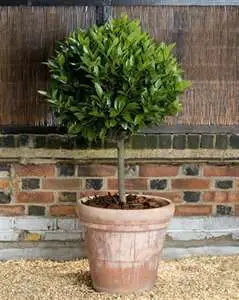
A simple
way to tell whether a tree or shrub was properly maintained at the garden
center is to check the height of the potting soil. It should reach within an inch of the
container’s rim and feel moist to the touch.
Planting
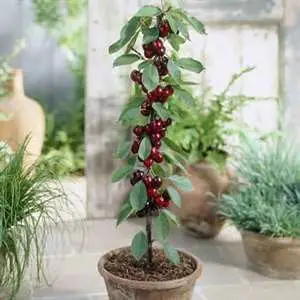
Once you’ve decided on the tree, select a pot that is the right size. Trees in container gardens should be planted in a pot or box that is twice the width and depth of the root ball. A rule of thumb is to have a foot in container diameter for every 4 feet of mature plant height.
Most trees in container gardens
grow well in loose, well-drained soil with a little added compost. All
varieties benefit from adding a slow-release organic fertilizer to the potting soil mix. Apply a
balanced fertilizer once in spring and in summer. Don’t fertilize in autumn. If new growth is generated then, it will be
susceptible to killing winter frosts.
Underplanting
Underplant your trees with flowering or vining annuals or perennials for some color.
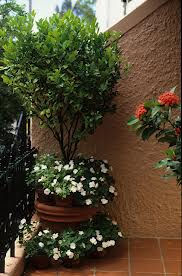
When a tree
has been trained to an unusual form, it will likely come attached to a stake in
its pot. Leave the tree attached to the stake
when transplanting. If the stake is
flimsy, replace it with a sturdy one and tie the tree to the new stake with
soft ties.
When you plant, measure the height of the root ball. Then, add an
inch or two of pea gravel to the bottom of the container to help with
drainage and add soil. You will want to add enough soil so that when
you sit the root ball down in the container, the top of the ball will be
at the same level it was in its nursery pot – about two inches from the
top rim of the container.
Fill the rest of the container with soil. Make sure you leave an inch or two of soil around the sides and bottom of the root ball. Tamp the soil gently around the roots. If you need to add a support
stake or two, do it at planting time.
Water thoroughly, making
sure you reach the roots. If you’d like to add a little mulch or pea
gravel on top to hold in moisture or to improve the appearance of the
pot, that is fine.
In most areas, spring is the best time for planting trees in container gardens. In
mild areas, any time is okay.
Maintenance
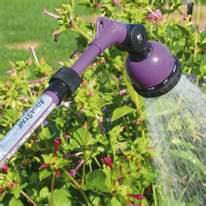
Watering is a concern for all potted plants, including trees in container gardens. When it gets dry, a tree stops growing. Even large containers with too little water and nutrients will stunt or dwarf the plant.
When your tree begins to
show signs of needing water every day, it needs to be moved to a larger pot – one about 4 inches bigger in diameter should be enough.
Regular maintenance is fairly simple. Keep suckers and stray stems trimmed, and keep a nice shape. Prune after blooming, or in fall in most climates.
In the spring, remove the top 1-2 inches of soil from the container and replace it with fresh potting mix. Add fertilizer to the mix when you do this.
Recommendations
Below are some of the best trees to try in your container gardens as recommended by the experts. If you are interested in fruit trees for edible gardening, please visit that page too.
Standards
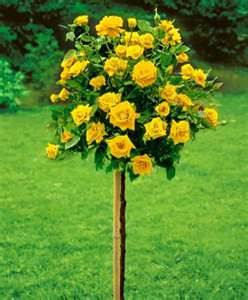
Standards aren’t trees but they are shrubs that have been formed to look
and act like trees. Their lower branches are removed to form a trunk.
Some to try would be:
For additional plants that will add form and permanence to your garden areas, go from Trees in Container Gardens to Shrubs in Container Gardens.
Return Home enjoycontainergardening.com



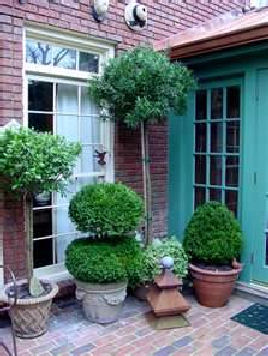
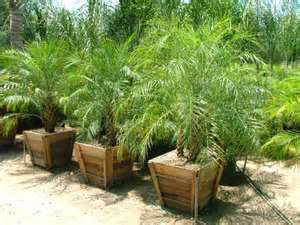

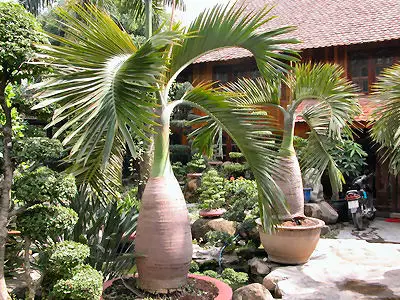











New! Comments
Please leave me a comment and let me know if you like what you see here and if the information is helpful. Thanks.